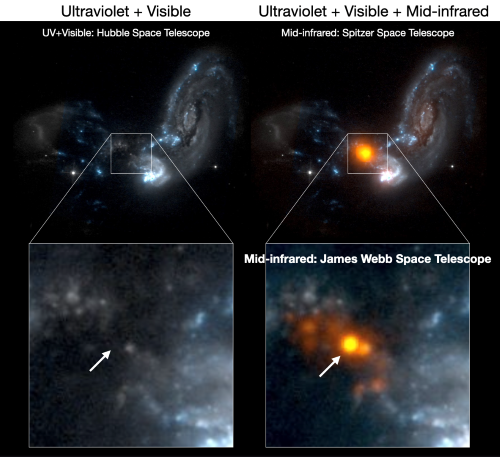The James Webb Space Telescope was utilized by scientists to determine the accurate location of a strong energy source hidden by cosmic dust present in the luminous merging galaxy IIZw096.

JWST pinpoints the ‘invisible’ engine that powers the galaxies in the middle of a collision. Astronomers from an international team have used the James Webb Space Telescope to reveal, for the first time, the exact location of the source powering colliding galaxies. Curiously, this source lies outside of the main parts of the galaxies and is not visible at all in the ultraviolet or visible light observed with the Hubble Space Telescope. Image Credit: Hanae Inami/Hiroshima University.
Approximately, 500 million light-years away, next to the constellation Delphinus, two galaxies are colliding. Named merging galaxy IIZw096, this luminous phenomenon is concealed by cosmic dust, but scientists initially determined a bright and energetic source of light 12 years ago.
Now, with the availability of a more sophisticated telescope—the James Webb Space Telescope that began its observations in July 2022—the group has spotted the accurate location of what they have named the “engine” of the merging galaxy.
The researchers reported their outcomes in The Astrophysical Journal Letters on November 15th, 2022.
The James Webb Space Telescope has brought us completely new views of the universe thanks to it having the highest ever spatial resolution and sensitivity in the infrared.
Hanae Inami, Study Corresponding Author and Assistant Professor, Hiroshima Astrophysical Science Center, Hiroshima University
Inami added, “We wanted to find the ‘engine’ that powers this merging galaxy system. We knew that this source was deeply hidden by cosmic dust, so we could not use visible or ultraviolet light to find it. Only in the mid-infrared, observed with the James Webb Space Telescope, do we now see that this source outshines everything else in these merging galaxies.”
Since galaxies tend to merge, their stars, planets, as well as other constituents could crash into one another, thereby making the debris act as fodder for new celestial episodes.
The majority of such galactic collisions only discharge infrared light, which consists of longer wavelengths compared to light visible to humans and is beyond the scope of human perception. In 2010, utilizing the Spitzer Space Telescope, the same team discovered that the merging system was dominated by bright infrared emission.
Owing to the telescope’s limited resolution, the scientists could quantify the power of the engine and the source of such brightness but could not determine its exact location.
With the availability of the James Webb Space Telescope, they discovered that this engine is accountable for the bulk of mid-infrared emission, which accounts for up to 70% of the complete infrared emission of the system.
Also, they discovered that the source has a radius no bigger than 570 light years—a small fraction of the size of the merging system, which is approximately 65,000 light-years across. This shows that the energy has been confined to a small space, according to co-author Thomas Bohn at Hiroshima University.
Bohn stated, “It is intriguing that this compact source, far from the galactic centers, dominates the infrared luminosity of the system.”
Bohn feels that this source makes a considerable contribution to the merging galaxies in spite of lying in the outskirts, similar to a speck of pepper on the white of a fried egg.
We want to know what powers this source: is it a starburst or a massive black hole? We will use infrared spectra taken with the James Webb Space Telescope to investigate this. It is also unusual that the ‘engine’ lies outside of the main parts of the merging galaxies, so we will explore how this powerful source ended up there.
Hanae Inami, Study Corresponding Author and Assistant Professor, Hiroshima Astrophysical Science Center, Hiroshima University
Co-author Jason Surace of the California Institute of Technology stated that the finding aids more recently developed knowledge of the universe and how it changes.
Surace stated, “The last few decades, driven by new, mostly space-based observations in the infrared, have shown that the universe is a surprisingly dynamic and violently changing place. In times past, it was thought that the galaxies—the largest things we knew of—simply spun essentially unchanging, like celestial temples in the heavens.”
Besides determining the engine’s location, the scientists found 12 “clumps” of light. While few of these were earlier disclosed by the near-infrared abilities of the Hubble Space Telescope, five were detected newly with the James Webb Space Telescope. Inami said that these are ejecting mid-infrared colors that show they are forming stars.
The James Webb Space Telescope mid-infrared imaging described in this paper revealed a hidden aspect of the merging galaxy IIZw096 and opened a door towards identifying heavily dust-obscured sources which cannot be found at shorter wavelengths.
Hanae Inami, Study Corresponding Author and Assistant Professor, Hiroshima Astrophysical Science Center, Hiroshima University
Inami added, “Future planned spectroscopic observations of IIZw096 will provide additional information on the nature of the dust, ionized gas, and warm molecular gas in and around the disturbed region of this luminous merging galaxy.”
This study was performed as a part of the JWST Early Release Science (ERS) Program of the Great Observatory All-sky LIRG Survey (GOALS) project, which aims at four local merging galaxies, including IIZw096.
The study was financially supported by the Japan Society for the Promotion of Science, the National Science Foundation, the Grote Reber Fellowship Program administered by the Associated Universities, Inc./National Radio Astronomy Observatory, the Simons Foundation, NASA, the European Research Council, the Swedish Research Council, the Knut and Alice Wallenberg Foundation and Spain’s Ministry for Science and Innovation.
Journal Reference
Inami, H., et al. (2022) GOALS-JWST: Unveiling Dusty Compact Sources in the Merging Galaxy IIZw096. The Astrophysical Journal Letters. doi.org/10.3847/2041-8213/ac9389.